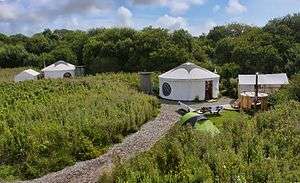Glamping
Glamping is a portmanteau of glamour and camping and describes a style of camping with amenities and, in some cases, resort-style services not usually associated with "traditional" camping. Glamping has become particularly popular with 21st century tourists seeking the luxuries of hotel accommodation alongside the escapism and adventure recreation of camping.[1][2][3][4][5]
History
The word "glamping" first appeared in the United Kingdom in 2005.[6] While the word itself is new, the concept that "glamping" connotes, that of luxurious tent-living, is not. In the sixteenth century, the Scottish Duke of Atholl prepared a marvelous glamping experience in the Highlands for the visiting King James V and his mother. Here, the Duke raised lavish tents and filled them with all the provisions of his own home palace.[7]
At around this same time, the Ottomans had ostentatious, palatial tents transported from one military mission to the next. Entire teams of artisans traveled with the army to erect and maintain these imperial tents. As described by Professor Nurhan Atasoy,
The exquisite ornamentation both inside and out of the tents used by the Ottoman sultans made them imposing dwellings fit for a ruler. On ceremonial occasions tents served to create a splendid theatrical setting, as we see vividly portrayed in miniature paintings depicting banquets, audiences and celebrations which took place in the imperial tent complex over the centuries. The imperial tents were richly decorated as if they were pavilions, and often had designs resembling tiled panels, usually in floral patterns, either in appliés work using cloth of different colours, or embroidered in various stitches using silk and metal thread.[8]
Fast forward three centuries, and we find more examples of early "glamping." In the 1920s, African safari became the thing to do among wealthy Brits and Americans. But wealthy travelers, even those in search of adventure, were not willing to sacrifice comfort or luxury. From electric generators, to folding baths, and cases of champagne, travelers were afforded every domestic luxury while on adventure.[9]
Glamping is its modern equivalent, combining both yesterday's amenities and today's technology. Also called boutique camping, luxury camping, posh camping, or comfy camping, today's glamping features such structures as yurts, tipis, pods, bell tents, vintage caravans, vintage trailers, safari tents, tent cabins, and tree houses.[10] Glampsites range in price from as little as $50 per night to thousands of dollars per night, depending on amenities, which can include fresh bed linens, en suite washrooms, food service, and private verandas.
Glamping has also become a popular term amongst women vintage caravanners who deck out their caravans and vintage trailers with feminine touches such as fine linen, lace, floral curtains, bunting and decorate them with retro items and fine china to combine their love of adventure with the desire to create a peaceful home-like retreat.
Concept
Today's concept of glamping has its roots in these earlier forms of luxury camping. In a positive twist on these old forms of tent-living, however, glamping today is not within the exclusive purview of the rich. To the contrary, some form of glamping is accessible to most travelers: a quick search for glamping accommodations around the world reveals an incredible range of per night prices.
While the number of international glamping options has skyrocketed since the word first appeared in 2005, the main philosophy behind glamping has remained the same: sustainable, quasi-outdoor lodging that offer travelers comfortable experiences in nature.
See also
| Wikimedia Commons has media related to glamping. |
References
- ↑ Lickus, Jay (11 March 2015). "Have You Ever Been 'Glamping?'". Huffington Post.
- ↑ Southerden, Louise (19 March 2015). "Six of the best: New Australian glamping camps". Sydney Morning Herald.
- ↑ Devine, Darren (17 March 2015). "Glamping's yurts, podes and domes continue to lead way for Welsh tourism". Wales Online.
- ↑ "'Glamping' brings creature comforts to outdoors". USA Today. 2011-08-04. Retrieved 2011-09-27.
- ↑ "Glamping". campsites.co.uk. Retrieved 30 September 2016.
- ↑ Harpaz, Beth (4 September 2014). "Glamping? Staycation? Travel Industry Loves Made-up Words". Today.Com. Retrieved 2 February 2016 – via today.com.
- ↑ See Robert Lindsey, Sixteenth Century Glamping, The Atholl Hunt.
- ↑ Professor Nurhan Atasoy, "The Ottoman Tents," Turkish Cultural Foundation
- ↑ Bull, Bartle (1992). Safari: A Chronicle of Adventure.
- ↑ "What is glamping(glamorous camping) & types of glamping accommodations". Retrieved 19 February 2015.
